Forza Motorsport 2 Walkthrough
Ready to hit the track again in Forza Motorsport 2? GameSpot's Primer will help you get started!
Design: Randall Montanari
It's been two years since the original Forza Motorsport appeared on the Xbox. Unlike most of the arcadish racing games for that console, Forza was a full-on racing sim, with hundreds of intricately recreated real-world cars, a deep tuning setup, and a mostly good damage model (which is still missing from the grandaddy of console racing sims, Gran Turismo). Although it was a new series, it still made an immediate impression on racing fans and earned top marks and numerous awards.
Now, two years later, Forza is bursting onto the Xbox 360 with Forza Motorsport 2. As you might expect, it includes the same racing formula as Forza Motorsport, but with enhanced graphics, more cars, and some new features. Like the Forza 2 game itself, this primer is an upgraded version of our primer for Forza Motorsport, but with edits and new sections to detail some of the new features. Enjoy!
Getting Started
When you first boot up Forza 2, you're going to notice three primary options for getting into the game: Arcade, Career, and Multiplayer. The Multiplayer choice is fairly self-explanatory, in that it will let you pursue your dreams of online domination, or let you play via System Link or Split Screen. The two main single-player modes, though (both of which will tie into online play as you proceed), are Arcade and Career.
Arcade Race
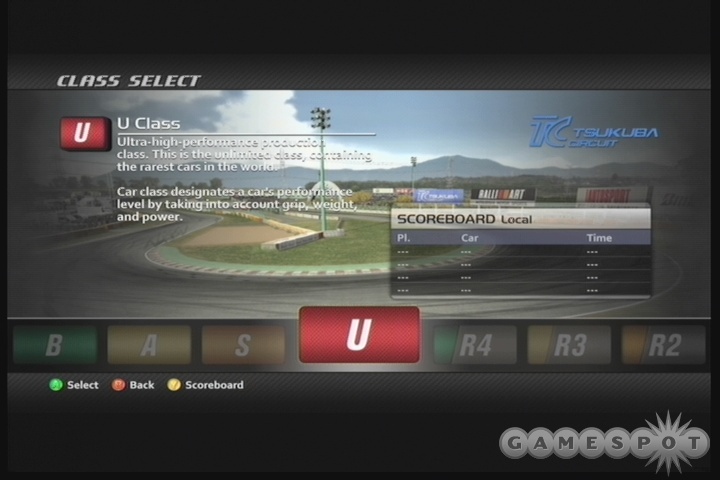
Arcade Race is going to be preferable for players that want to get right in on the action, as you'll start out with most (but not all) of the cars in the game unlocked and available for your use. You can choose any car you wish for the races here, but the computer will adjust your competition based on the class of car that you choose, so if you pick a speed demon race vehicle, you can expect to be going up against likewise speedy opponents. In order to unlock more cars and tracks, you'll need to conquer the races that are available at the beginning of the mode, then proceed along the line until you wind up at the formidable full Nurburgring challenge.
If you wish, you can use cars from your Career Mode to race in Arcade mode, and this can be handy. If you upgrade a car so much that it bumps into a different class, though, you'll need to be careful that you're not putting it up against cars that it can't compete with. In general, if you upgrade a car more than one full class (e.g. if it goes from C to A), then you're probably going to be outmatched when you take it to the track against cars that started their lives in the A class. This isn't always the case, but just in general, to compete in races with a class restriction, it's better to take a car that's already in that class and attempt to max it out instead of bumping up a car from a lower class.
Career Mode
Most players, however, are going to want to jump into Career Mode, which is going to let you start out as a hip young cop, sent undercover with your partner, a reformed street thug, to infiltrate a band of highway pirates and their gritty, underworld street-racing empire. Along the way, you'll learn about life, love, and what it means to be a man.
Well, that's all entirely false, except for the part about you being a cop. Well, OK, that's a lie too. In Career Mode, you're going to start out with nothing but a small war chest of cash, and absolutely no cars at all. In order to start working your way up through the ranks of the international racing elite, you're going to have to start small.
Region Choice
Before you can begin a career, you're going to have to choose a region to base your driver in. This is a permanent choice, and one that can have an impact on your finances, but won't limit the kinds of cars you can obtain. As the manual says, no matter what your choice of region, you'll eventually be able to obtain all the cars in the game, and will also be given access to all the tracks, as well. There are three areas in which your choice of region will affect your game, though.
Car Prices and Rarity
Region choice affects the price of cars, so that a North American driver will have to pay more for cars that come from Europe and Asia, while an Asian driver will have to pay more for cars coming from Europe and North America, and so on. This is more important when dealing with A and S-Class cars than with other car classes. The lower class cars are going to be the product of large production runs, for the most part, and thus will be relatively common in all regions, while the purpose-built race cars in the R class are going to be equally rare (and thus equally expensive) in all regions.
The rarity of a car is also affected by your region. Rarity doesn't have an effect on a car's gameplay mechanics, but the more rare a car is, the more cash you'll earn by winning races with it. Why? Heck if we know. Maybe the race organizers give you a bigger cut of the cash for drawing in more spectators with your uber-rare ride. Regardless, using a rare car will net you more cash, but you shouldn't cripple your chances of winning a race by using a car that's more rare, but which performs worse than your other choices.
Initial Car Selection
Your choice of region is also going to affect the initial car selection. You're going to start the game with 11,000 credits and a selection of cars to choose from, each of which will set you back between 8,000 or 11,000 credits. Now, we'll be the first to admit that you can choose anything you like, but an examination of the cars in each region will usually convince you that a certain model of car is going to be objectivly better than the other choices. For Europe, the 2004 Audi TT Coupe 3.2 quattro will be decent if you like a 4WD vehicle, but otherwise, the 2006 Volkswagen Gold GTi will be the best choice for speed and overall performance.
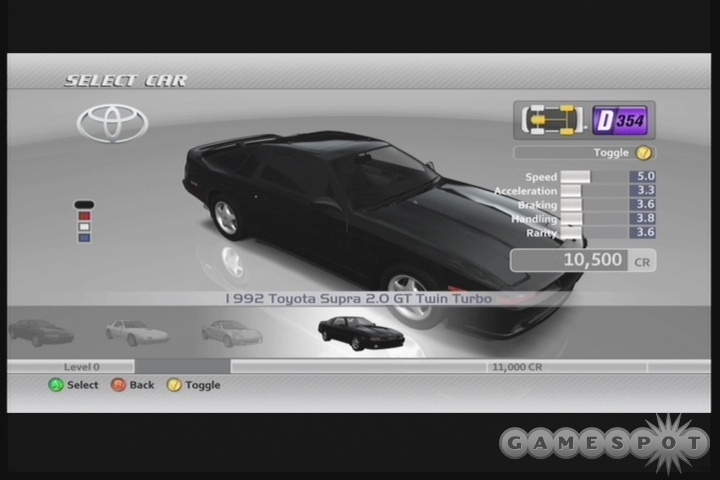
In North America, the 1998 Chrysler Eagle Talon TSi Turbo is somewhat cheaper, but faster, although it is a 4WD vehicle which may make it more difficult for you to shift over to a RWD vehicle later on. The 2005 Chevrolet Cobalt SS Coupe is less speedy, but has better handling, and is marginally rarer, letting you gain more money in the early races. The 2003 Lexus IS300 may be the best here, though, as it's a RWD and has great speed and rarity ratings.
For Asian drivers, there are plenty of RWD cars here, but the obvious choice is the 1992 Toyata Supra 2.0 GT Twin Turbo, which has the highest initial speed rating of any of the starting cars from any region.
Basically, these choices all have something in common; they're faster than their counterparts in the early game. You might be saying "well, duh!" but in the D-class of cars, which is where you'll be starting out, it's important to note that speed differences between cars are going to be much more important than will handling. Handling will become an integral part of the game in the upper classes, where braking distance and turning ability will often decide your ability to win a race, but at the outset of career mode, he who goes fastest wins. After all, when you're barely busting out 100 MPH from corner to corner, you're going to have a pretty easy time slowing down and turning as compared to a car with 600 horsepower and a top speed of 230 MPH. So pick your starting car based on its acceleration and speed rather than any kind of handling consideration.
Level-up Rewards
Your progress in the Career Mode of Forza 2 is dependent on your level, which you increase by earning cash in races. What's more, each time you earn enough cash to increase your level, you'll earn a reward from either your home region or a car manufacturer. The costs of cars from your home region will plummet after gaining a few levels, and will continue to decrease as you level up your driver. Most of the level-up rewards after the fifth level are simple car unlocks, allowing you to buy new cars at various dealerships around the world, but every fifth level you'll also receive a free car from a dealership, usually one of the ones in your home region.
Starting Out
When you have your region and initial car selected, it's time to start hitting some races and earning some cash. At the outset of career mode, you should have at least three events unlocked in the Proving Grounds race type, but you'll only be able to compete in one, since they're keyed to the region you came from.
If you took our advice and obtained the fastest car available to you in the initial selection, then you shouldn't have a problem winning these races, assuming you're decent at cornering and keep the AI set to medium in the difficulty options. At worst, you're going to be facing off against a bunch of cars that don't really stand a chance against you and one car that's of the same make as the one you bought, making most of these early races a straightforward duel, and one you should handily win, since the AI doesn't quite max out the speed of its cars on medium difficulty. (If you intentionally crippled yourself by buying something like the Mini Cooper, then you'll probably have to dial the difficulty down to Easy to even have a chance of winning these races.)
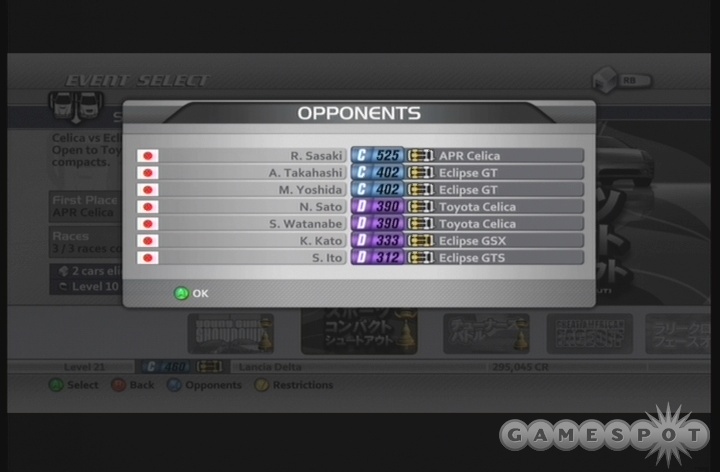
So, you should be able to win some of the early races without building up much of a sweat. Each time you win a race, you'll earn cash, which will quickly increase your level, and each time you complete a self-contained series of races, you'll also earn a new car. (Assuming you managed to get a #1 ranking in all of the races, that is.) These new cars will likely be inferior to the one you bought when you chose your region, but the important thing about them is that they'll let you enter races that your initial car isn't qualified for.
Speaking of which, this mechanic should be familiar to anyone who's played a Gran Turismo game, but just so we're clear, you won't be able to upgrade and overpower a single car and use it to blast through all of the races in Career mode. Most of the race events will have restrictions on them, so that you'll be forced to use a 4WD vehicle to get through one set of races, then switch to a RWD vehicle for the next group, and so on. Each event will detail what's required for it, and also let you know if you have any cars in your garage that are suitable for the event; if you wish, you can immediately switch to an eligible car and use that to try your luck at the races. If you don't have any eligible cars in your garage, you can either check the restrictions and try to buy a car that matches, or just wait until you get a race reward that fits the restrictions.
In addition, you'll find that most of the events in the game are locked and unavailable to you when you first start out. Gran Turismo vets will be pleased to learn, however, that there aren't any license exams or hoops to jump through in order to gain access to these events; instead, they're automatically unlocked as you gain levels. In most cases, these races will be unlocked around the same time that you'll have earned enough cash or will have earned cars that can actually compete in them; if a race is locked to you, in other words, you probably wouldn't be able to win it even if you were able to enter, as you wouldn't have the appropriate cars to really compete.
The Plan
So, in order to progress through career mode, you're going to have to earn or buy more cars and use them, in turn, to earn cash in the highest-level races available to you. The earliest races will usually offer you around 1,000 credits per race, which will be enough to unlock new races as you increase your level; you'll also increase your stable of cars as you win events, allowing you to try the different races as you unlock them.
Now, depending on your skill level, you may either want to find races that provide an even match for your cars, or, if you're just looking to progress a bit, you'll want to find races that you can easily win with a certain car. In general, the quickest way to cheaply earn cash will be to hop into your most powerful car and head to the races. You can repeat races for more cash as many times as you like, so if you find a high-paying event that you can win easily, feel free to start racing it over and over again, if you like, to build up more cash for upgrades and new car purchases, and to earn more levels to unlock new races and earn new free cars.
Keep in mind that the gap between levels is going to increase as you go ever-higher, which means that the early, low-paying races will eventually stop being an efficient way of increasing your level, so you may want to find a high-paying event and see if one of your cars is competitive in it, and if not, then either buy a new car or upgrade one of your earlier ones to give you access to more cash rewards. You increase your level by earning more cash, not from your total cash reserves, so there's no reason not to invest in some upgrades if you think it'll help you win races that wind up paying more.
General Career Tips
Simulate Qualifying
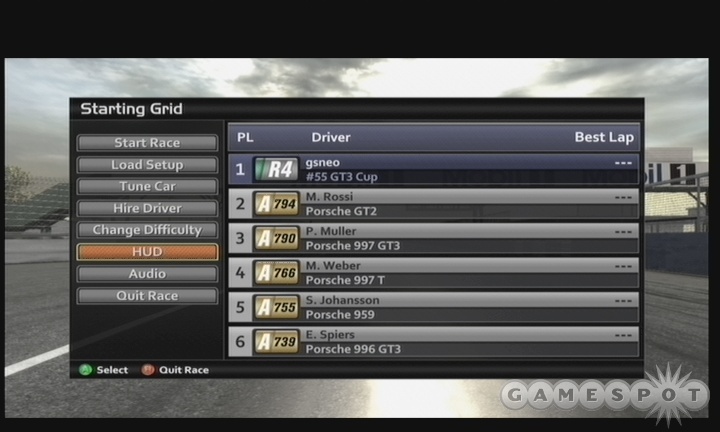
Often times you can get a feel for your chances of winning a race even before it begins, thanks to Forza 2's on-by-default qualification simulation. Before every Career Mode match, your 360 will take all of the cars in the race and simulate qualifying laps for them, and rank them accordingly on the starting grid. If you're in first place on the grid at the outset, then there's a good chance that your car is the best on the track, and you'll probably be winning the race no matter what. If you're in second place, and the car in front of you is a different model vehicle, then it will likely get a bit of a jump on you off the line, but you should be able to overtake it with skilled driving.
For our purposes, we didn't even bother to try races where we qualified in fourth place or lower, as we found that the car that qualified in first place is usually almost impossible to catch up to in these situations, barring some severe pack-ramming on the first turn. In situations like these, we just quit out and waited for a more powerful car to come along before trying the circuit again. If you really want the car that's available as a first-place prize, though, feel free to switch everything down to easy mode and give a difficult race a whirl in the best car you've got.
Getting Extra Cash
You can earn extra cash in Forza 2 by adjusting some of the difficulty settings in the options menu. Here are the best options for getting extra cash without making the game too frustrating.
Enable Simulation Damage: The default damage setting, Limited, will still let you damage your car; it'll just prevent systems from taking more than 50% damage. Unfortunately, that's generally going to be more than enough to cripple your car and prevent you from taking first place, which - let's be honest - should be your goal for every race you enter. If you're going to restart the race when you take enough damage anyway, you may as well set damage to Simulation mode. You'll earn 10% more credit for each race, and if you're able to get out front of the pack and avoid collisions, you're unlikely to take any damage anyway.
Bump the AI Settings: If you're interested in even more cash, then after racing a little while, you'll be able to set the A.I. Difficulty to Hard for a 10% bonus to your rewards. This isn't going to be an easy setting to deal with if you're like us and have a tendency to play with a loose, arcade-like driving style, but for races where you can bring a preponderance of firepower to bear, this is essentially free money. What we mean by this is that after you unlock certain powerful cars by winning races, you should find yourself absolutely dominating some of the races that they're eligible for, even without modding them.
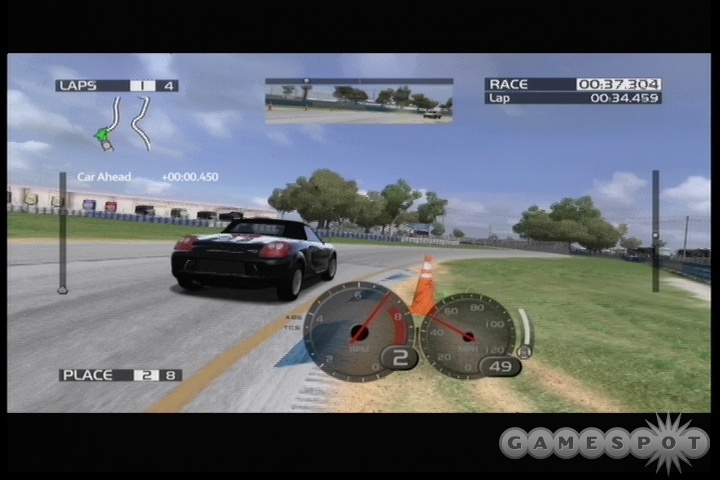
True, some of the cars that you receive for winning races are going to be trash, especially early on, but some of them, such as the Tommy Kaira M20b that's unlocked in the Goodyear 150HP Invitational that you can compete in at level 7, are expensive and powerful vehicles. (The Impreza retails for 141,000 credits, for instance.) The reason these cars will help you win on Hard difficulty is because they're going to simply outspeed most of the competition in the races that you've unlocked, allowing them to pull away from the pack in the straights, even over short straits, which thus makes these races much more forgiving of turning mistakes on your part. The aforementioned Impreza will be able to easily win races like the Asian Open, the AWD Shootout, and the Boosted Shootout, all without any modifications, even when the opponents are set to Hard.
You'll need to judge the relative strength of your car before deciding whether or not to run with Hard A.I., though, as harder A.I. settings in a field with relative parity will probably result in some swift drops to the back of the pack, unless you're quite good at following a proper line and cornering. Still, though, if you're able to beat cars with both simulation damage and Hard A.I. on, you can increase your winnings by 20% per race.
Maximum Cashola: Of course, if you're absolutely destroying the competition in a certain event, then feel free to switch all of the difficulty options so that you get extra cash. The maximum boost you can earn is +50%, which isn't quite as good as the first game's +100% bonus, but which will definitely help your financial stability in the long run, especially when you get into the races with big rewards. Switching off all of your automated systems will result in a car that's very difficult to control in turns, though.
Class Warfare
One of the more intriguing concepts in Forza 2 is the ranking of each car into a class, based on its real-world rarity and purpose. Cars you can walk up to a dealership and buy in an hour are going to be low-class (and generally low-power) vehicles, while the higher-class vehicles are going to be, as in the real world, very expensive and difficult to obtain.
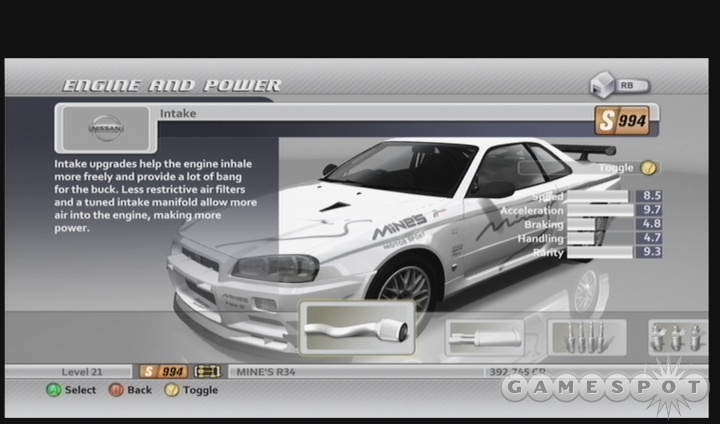
Classes range from D (worst) to U (best) for production cars, with a separate ranking of R for specially-made race cars. Like in the first Forza 2, there are numerical rankings assigned to each car, but in Forza 2 2, these not only rank it within its class, but against all cars in the game. For instance, a D class of car will have a ranking somewhere between D145 (the lowly 1972 Lotus Elan Sprint) and D399. If a car's numerical ranking ever gets bumped up to 400, it would switch over to the C class.
The numerical breakdowns are thus: 100-400 for D class; 401-550 for C class; 551-700 for B class; 701-850 for A class; 851-998 for S class; and 999 for U class. You can use these numbers to gauge roughly how well a car will compete when it goes up against other cars in the same class, or to determine how far you can upgrade it before it bumps up to another class. You don't always need to pick a car with the highest number when heading out to the track, though; there are differences in drivetrain and handling that may make a numerically inferior car preferable (to you) than one that's ranked more highly.
Class Upgrading
The key thing here, at least as it applies to Career mode, is knowing how far to upgrade a car. When you purchase new parts for a car in the garage, it's going to become more powerful, and thus will increase its class. For instance, if you buy a 2002 Lotus Esprit V8, then you'll be getting a car that comes to you ranked B695, which is near the top of the class of B-ranked cars. If you upgrade it even a bit, though, it'll bump itself up into the lower range of the A-class cars. Whereas it might have previously dominated the B-class races before, it will probably struggle against the A-class cars (unless you spend enough money on it to move it up to the upper edge of the A-class cars).
Thus, it's best to keep a car stock when you first get it, see which races it's qualified for, then try to enter those without upgrading to see how you do. If you need to upgrade, feel free to do so, but be sure to check the restrictions on the races to be sure that you don't wind up disqualifying yourself.
(Luckily, this isn't as much of a problem in Forza 2 as it was in the first Forza, since most of the races here are dependent on horsepower, drivetrain, or the make of the car; it's not until you reach level 15 that you'll unlock races that require you to maximize a car's performance within a given class.)
So, in short, you'll need to keep an eye on the class of your car when upgrading. If you upgrade within a class, say by taking a car from B551 to B695 by buying parts, then that'll rarely affect what races the car is qualified for. (Increasing your car's power will likely shift its ability to qualify for the Semi-Pro events, which are dependent on horsepower limitations. Taking the radical step of altering the engine and powertrain will also shift around its qualifications.)
Racing Tips
Most of your education in Forza 2 is going to have to come on the track; there are simply too many tracks and cars to give you any kind of projected walkthrough to the game, besides the basics of "go fast". You'll want to also check your manual for more general tips, as it has some decent info on passing and turning.
Using The Line
Anyone who played Forza on the Xbox will remember its famous dynamic racing line. It's back in Forza 2, but with a twist: it's now turned on by default only when you're cornering. That's not a bad change at all, as cornering is when you're mostly likely going to need it. You can still turn on the full line if you like, but that will simply leave you with a big green line in most of the straightaways. The full line can be helpful when dealing with curves that appear just after you crest a hill, but in most cases won't be needed.
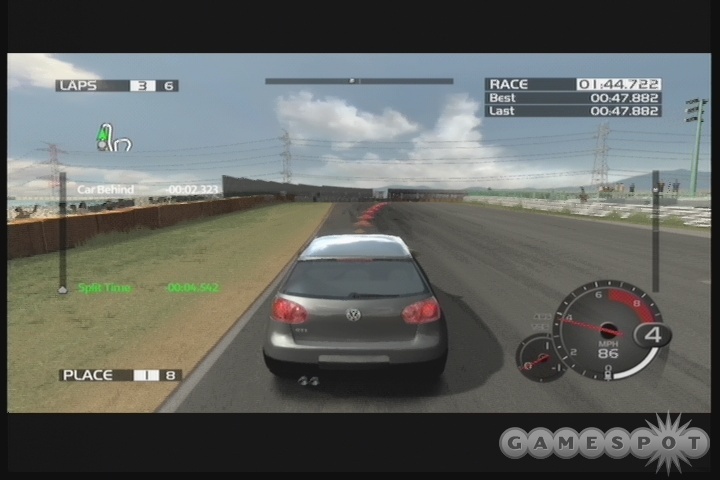
The line is, in essence, a tool that will help you know when you brake and turn so that you can learn how best to approach a corner and get through it. It is customized for each course, and will change colors based on your speed, with green indicating that you should be going full-throttle and red indicating that you need to brake, if you're using the classic always-on line. With the corner-only line, though, you're not going to get any acceleration indications; just an indication of how much faster you're going than you should be. Red means that you should break hard, dark yellow indicates that you really need to slow down, while light yellow indicates that you're slightly above the desired speed. If you drop below the desired speed for a turn, the line will disappear entirely, instead of turning green.
The key to dealing with the line is, oddly enough, knowing when to ignore it. It is a fantastic tool for learning courses, but won't necessarily always apply to your car or driving style, so as you get a feel for how your favorite rides handle, you may find yourself using it more as a guideline than a hard and fast rule, or even turning it off altogether. The thing about the line is that it's a model of the path you follow in a perfect situation, and said situations are unfortunately somewhat rare, especially when dealing with numerous cutthroat A.I. opponents. It also doesn't always take into account the differences in braking and acceleration between all cars. You'll need to play around with a car on different tracks to see exactly how to adjust your path to the line. Cars with excellent braking may be able to travel into the red zone before pumping the brakes, for instance, while cars with oversteer or understeer may have to deviate from the line in order to get through turns.
Short Turns
One of the interesting aspects of the racing line is the way it often inserts yellow and red segments into short turns of no more than 20 degrees. Although top-end racing cars with extreme top speeds may find these handy, most of the cars you're going to be using throughout the game will be able to handle these turns simply by undercutting the line while staying at top speed, eliminating the need to brake; at worst you may just want to lay off the gas a bit before heading into the turn. (Turn 2 on the Maple Valley Raceway Short course is a good example of this.) The exception here is, of course, areas where chicanes or short turns precede sharp turns; if you attempt to speed through one of these, then you may find yourself poorly equipped to deal with the subsequent turn.

The line also doesn't usually take into account corner-jumping techniques. While corner-jumping and rail-riding isn't often a technique that will net you a big position bonus, mostly due to the way that the courses are laid out, it's worth noting that the line will never indicate when it actually might be faster to ride up onto a rail or jump a corner entirely. A bit of experimentation in areas with grassy terrain may net you some speed bonuses, but you can expect to damage your tires a bit even when you do find a quicker line. You will also take a time penalty when more than two of your wheels hit the grass at the same time, so if you're looking for a new time record, then this isn't your best bet, but if you just want to win a race, then you could do worse than attempting to jump a corner here and there.
Brake In, Gas Out
The primary difference between simulation racers and arcade racers comes in their handling of turning. If you're playing a game like Need For Speed: Underground, then you may be able to get through a turn by just hammering the accelerator and scraping along the outside wall until you come to the end of the turn, but in Forza 2, you're going to have to approach turns with a bit more respect. In other words, you're not going to be able to turn with the throttle open all the way; you're going to need to brake until your car hits a sweet spot of maneuverability and speed, allowing it to get through the turn as quickly as possible while still retaining control. When done properly, you'll gain speed over the course of a track, even if you spend a lot of time braking, since uncontrolled turn approaches will often send your car off the track, or force you to correct your path and cause significant time delays.
The most important thing to remember is to try and brake while you're still travelling straight ahead, if at all possible; braking while turning your car reduces the effectiveness of both actions. The "best" approach to a turn will usually have you braking while you're still approaching, reducing your speed to a manageable amount, and only then starting to turn while accelerating to try and stick to the line. On many courses, you won't be able to get from one corner to the next without braking at least a little while turning, but just remember that doing so decreases stability and will be likely to get you off the ideal racing line.
Also, keep in mind that you don't want to always wait for the line to turn red and then slam on the brakes. It's best to approach a turn while slowly easing onto the brake. Slamming on the brakes will cause a lot of instability in your tires and will often cause you to miss the sweet spot of speed for a turn, especially on the shorter turns. It's better to be going slower than faster in most instances, but if you do jam on the brakes, you can reduce the amount of friction that's available to you for turning. Ease on them when possible, but not to the point where you're getting passed.
Know The A.I.
One thing we can say for sure is that Forza 2's AI is pretty good for a racing game, especially with regards to how they pass. The cars here will, like human opponents, usually attempt to pass you up on a turn, and will often completely disregard the line while doing so. While they're perhaps a tad bit more tentative than the opponents in Forza were, they'll still tend to undercut corners and even jump them in order to get ahead of you. They're not afraid of a little bumping, either, so be forewarned; they will usually hold off on being aggressive unless you bump them first, though.
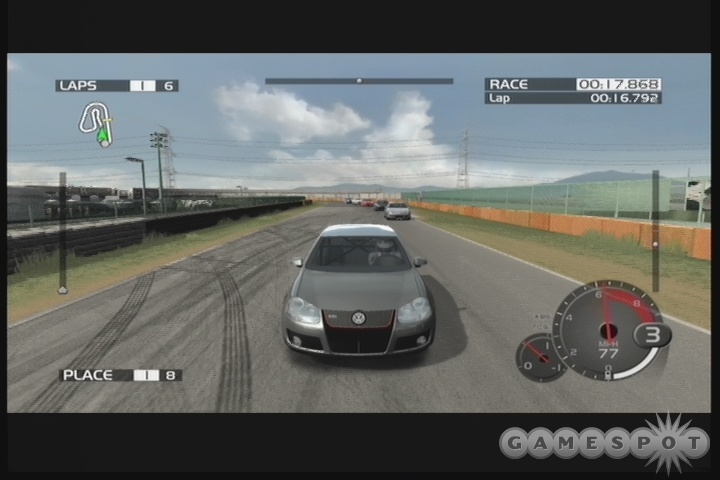
If you happen to be out in front of a car that is your equal or superior in terms of speed, then, you're going to need to learn how to block off your foe properly. If you're using an exterior view, then you'll have to hit Y to check your rear view; in-car viewpoints have a handy rearview mirror already set up. (You can also use the right analog stick to look all around your car.) When you're in front of such a car, all you really have to do is do your best to keep yourself in front of them. They'll almost always try to pass you on the inside of a turn and proceed to block you off when they get past you, using their car as a shield to prevent you from accelerating and passing them, or they'll just push away if they're capable of it and dust you.
In order to prevent this strategy from working, you will, of course, have to try and stay in front of their car when they head inside on a turn. This is going to result in a pretty awkward turn for yourself, as well, but so long as you prevent them from getting past you it won't matter much, as you'll both be forced to slow way down; so long as you're still directly in front of them, they won't have much recourse but to follow your lead and wait for another opportunity to pass.
If a car does manage to bypass you, you should immediately try and get around it, if possible, as it will have taken the turn awkwardly in most cases and will require a bit more time than you to get up to full speed. The key here is to avoid actually ramming into them, unless damage is turned off; a good collision after a turn can wipe out your progress in a race and force you to restart it.
Upgrades and Tuning
Whether you're bringing a Lotus Elan or a mighty TVR Cerbera Speed 12 to bear on your favorite track, delving into Forza 2's tuning options will let you get a bit more bang for your buck. This section of the guide is intended to give you a very, very basic overview of the tuning commands in Forza 2 Motorsport. It'll only be a matter of time before there are FAQs detailing tweaks and tuning tips for the most popular cars in Forza 2, but for now, you're going to have to adjust and tune your cars yourself. We're not going to delve into specific recommendations here, just tell you basically what the settings do and how they'll affect your car.
Upgrades
As in the Gran Turismo games, Forza 2 will allow you to both buy upgrades to your cars and tweak their settings manually. (Manually tuning car settings will indeed usually require you to have purchased some upgrades first.) If you're intimidated by the tuning screen's complexity, then, well, don't worry about it; just buy the upgrades that you can and leave the tuning options on default. Upgrades alone will work to increase the raw power and stats of a car, so if you're just looking for something "better," just take it to the shop and buy whatever parts you can afford for it.
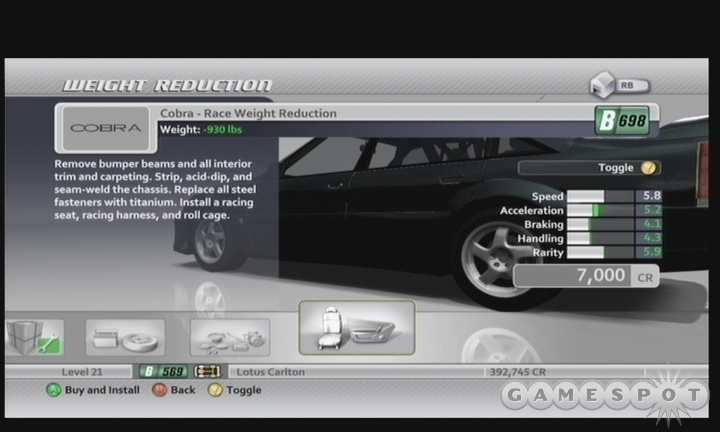
Upgrades are expensive, but most cars can be given a large (100-150 point) boost by purchasing a Race Weight Reduction package for them in the Platform and Handling section of the upgrades menu. Reducing the weight of a car won't usually affect its top speed, but it will make it quicker to accelerate, quicker to stop, and easier to handle, and usually at a relatively cheap price, too. That's usually going to be the first thing you want to buy for a car, but keep in mind that heavier cars are going to benefit from weight reduction a bit more than cars that are already pretty light. For instance, the heaviest car in the game, the Bentley Continental GT, will see its numerical rating go from B574 to A749 solely from a weight reduction upgrade (mostly due to the fact that its acceleration jumps from 4.4 to 6.0!) while the lightest, the Lotus Elan Sprint, will only go from D145 to D153 from a race weight reduction upgrade.
After the weight reduction, you'll want to bump yourself over to the engine upgrades and try to get the biggest acceleration gains that you can. Race cams and valves are good boosts for the money, but if you have cash to spare, you can throw all of your credits at the car and attempt to get the biggest bang for the buck that you can.
Tuning
Tuning can get you closer to a car that handles the way you like it, but it's also somewhat easy to screw things up if you don't know what you're doing. (You can always revert to the initial settings for your car, though, in case you happen to, say, entirely cut out the brakes.)
Tires
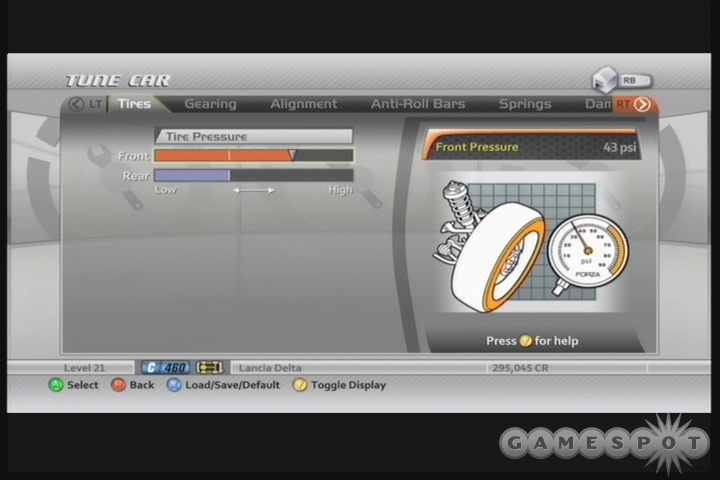
The main tire setting is pressure. You can increase the pressure here if you want more control in turns, but you overdoing this will result in more sudden slips when the tires suddenly lose their grip. Less pressure will increase grip by allowing more of the tire to contact the road, but the side effect of this is that you'll take slightly longer to turn off the forward axis.
Gearing
Properly tuning gearing ratios is one of the black arts of car adjustment; it can be difficult to adjust these properly unless you really know what you're doing, especially if you're adjusting the ratios individually, but well-tuned gear ratios can greatly increase your ability to succeed on a given course.
Higher ratios here (i.e. moving the sliders to the right) will increase your acceleration, while lower ratios (moving the sliders to the left) will increase overall speed. Luckily, with Forza 2's built-in benchmarking utility, you can quickly get feedback on the efficacy of your ministrations and correct any mistakes you might be making before you get too out of hand. In our experience, most cars can get a bit more top speed by individually adjusting the top gear, but it will take you longer to reach said top speed, so you'll only want to perform such tuning when dealing with a course with fairly long straights.
You can also attempt to twiddle with the lower gears and tighten up the ratios there for better acceleration on courses with lots of sharp turns, but in our experience, the preset settings were usually suitable for most situations.
Alignment
Camber: Camber affects how your car's wheels are tilted towards each other. A zero-degree camber means that the wheels are perfectly aligned when resting on a flat surface; negative camber will tilt the tops of the wheels inward; and positive camber will tilt the tops of the wheels outward from the body of the car. Increasing negative camber will reduce understeer, while reducing negative camber will reduce oversteer. You can adjust this individually for each axis, so if you find your rear wheels slipping on corners (we're looking at you, Tom's Z382 Soarer), you may want to try adjusting the rear axis by itself to see if you can't correct this.
Toe: Toe is similar to camber, but along a different axis. A negative degree of toe will result in "toe-in," where the fronts of your wheels will be closer together than the rear, while a positive degree of toe will result in "toe-out," where the fronts of the wheels will be farther apart than the rest of the wheel. For the front axle, toe-in will increase your turning ability but hurt your overall stability, while the situation is reversed with toe-out. Any kind of severe toe will decrease your tire lifetimes, meaning that you probably don't want to fool around with these settings too much if you're going out on an endurance race.
Caster: Caster affects the tilt of the steering pivot relative to the vertical axis. Only positive caster angles seem to be possible in Forza 2, meaning that the top pivot of the axis will be further towards the rear of the car than the pivot that actually connects to the wheel. A positive caster will increase the amount of camber that wheels are affected with while turning, allowing you to run with lower inherent camber numbers. On heavier vehicles, though, lower caster angles can increase responsiveness while turning, so you'll need to fine tune this in conjunction with your camber for maximum responsiveness in turns.
Anti-Roll
Anti-roll stiffness will affect how rigid the bar between the inside and outside tires is kept in a curve. Increased rigidity in the front anti-roll bar will increase understeer, giving you a bit more safety in blown corners, but it's mostly noticeable in long, flat corners, rather than in sharp turns. If you find that a car has too much oversteer in long corners, reduce stiffness and see if that helps.
Springs
Your spring settings affect how well your car handles uneven ground and cornering. Soft springs are a good thing when dealing with uneven ground and bumps, as stability will increase due to the increased movement of the springs. Stiffening the springs will decrease the speed of their movement, giving you improved control in corners.
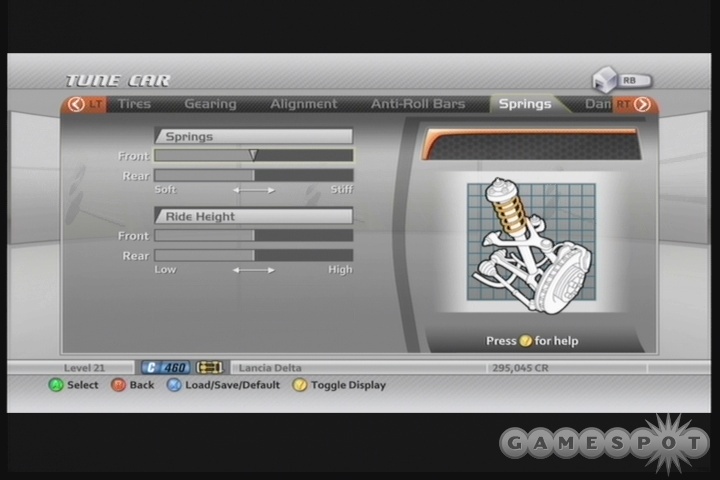
Your spring settings are going to be something you should adjust on a track-by-track basis. Tracks that force you through elevation changes through turns, such as many of the mountain point-to-point tracks, will benefit from setting a softer spring setting, as you'll gain stability. On flat tracks with sharp turns, though, you're going to want to have somewhat stiffer springs, as you'll be able to turn more precisely. You'll still need to be wary of sudden elevation changes, especially when it comes to grip pads on corners. If you hit a grip pad with two wheels while your springs are set relatively stiff and happen to bump those wheels into the air, it'll be quite difficult to regain control while still turning.
Ride Height: Ride height can be modified in the Springs menu as well. Generally speaking, you're going to want to lower the ride height as much as possible, as this is going to lower your car's center of gravity and increase cornering stability by letting your tires grip the road more closely. If you get too low, however, you can find yourself scraping the ground when heading over sharp bumps, which will affect your speed. If you're willing to test a car out on the track before using it in a race, you may want to just completely lower this setting all the way and take your car out for a spin on a course with some elevation changes. If you find yourself scraping the tarmac, start upping the height until you find something comfortable.
You can also attempt to adjust the front and rear height individually to increase downflow and give you more oversteer and a bit more acceleration off the line. You're going to want to have a lower front end than a rear in this case, but don't overdo it, or you'll have a hard time toeing the line in turns.
Damping
Damping acts as something of a counterbalance to your spring settings, in that you can manually adjust how quickly the springs recoil into their original state after absorbing a shock. There are two settings here: bump damping, and rebound damping.
Bump Damping: Bump damping controls how quickly the springs will recoil upwards after absorbing a shock from the road. Stiffening these settings will prevent the springs from coiling too quickly, thus preventing your car from diving too much when braking into a curve. These are individually adjustable on the front and rear, and you'll always want to have stiffer dampers in the front of a car than in the rear. When you have to brake hard when entering a turn, most of the energy in your car will shift forward, thus compressing the forward springs more than the rear; to keep your car balanced, you'll thus want to make sure that your front springs are a bit more resistant. Good braking emphasizes the shifting of weight to the fore of the car without too great of a "dive" effect, which will reduce traction on the rear tires and make for a less stable turn.
That said, you can overdo the stiffening of your dampers, especially if you also stiffened up the springs themselves for extra control. If you have stiff springs and dampers, you're going to have a lot of control, but your car will be quite bouncy; you'll want to soften up the dampers to get yourself back some stability and control over uneven surfaces. Overstiffening the front dampers in particular will prevent adequate weight-shifting and increase your braking distance.
Rebound Damping: Rebound damping controls how quickly your springs return to their normal positions after absorbing a shock. These need to be stiffer than the bump dampers, as they act to return stability to your car after braking, but setting them too high will likewise increase your braking distance.
Aero
Downforce: Downforce is an important component of a car's overall handling capabilities. When you've set up a car so that air flows more quickly underneath it than over it, the different air pressures will cause a net downward force on your car, thus causing your entire car to grip the road a little more tightly. This will give you better grip on your tires and increased control, but will also cause increased tire wear. Note that you can overdo downforce, which will cause your car to be sucked into the ground by a massive difference in pressure; this will result in sluggish handling, so try to stay in the sweet spot if possible.
Braking
Balance: With the balance bar, you can adjust the balance of braking forces between the front and rear brakes. Biasing this towards the rear will let you turn in more quickly, but will reduce stability, while favoring the front brakes will increase your stability while braking; helpful for those cars that tend to shudder or shake when you're slamming on the brakes.

Pressure: This affects the sensitivity of the brakes relative to the amount of force you apply to the brake pedal (or, if you're using a controller, the left trigger). This setting will largely depend on your car and the specific track you're working with. Having a higher pressure will increase brake sensitivity, which can be helpful on hairpins, but will make it more difficult to feather the brake on wider turns. By the same token, reducing total pressure will make it easier to feather due to the fact that the brakes will be less sensitive, but will make it tougher to lock up your brakes when going full-speed into a corner. Reducing pressure all the way will cut out your brakes entirely - try doing this on one of your buddies' Xboxes and see what happens the next time they load up a race!
Note that pressure here won't have much of an effect on your braking distance; brake balance is what you want to tweak for that.
Differential
Acceleration: Increasing acceleration differentials can help prevent squealing tires when powering through corners by increasing traction, thus letting you accelerate more quickly when coming out of a turn. If you push this setting too high, though, you can stiffen up your turning and reduce response.
Deceleration: Higher deceleration differentials will increase the traction of your wheels when braking into a turn, thus giving you mildly shorter stopping distances. On 4WD and especially rear-wheel drive cars, increasing your deceleration differential will also increase traction while braking, thus helping you turn in, but as with acceleration differentials, setting this too high will make for sluggish turns.
4WD Cars: Note that 4WD cars will have Acceleration and Deceleration settings for both their front and rear wheels, since power from the engine is used to rotate all of them. They'll also have a torque setting, which will enable them to shift power either front or rear, to increase or reduce oversteer and make the car handle more like a RWD or FWD car, within a limit.
Got a news tip or want to contact us directly? Email news@gamespot.com
Join the conversation